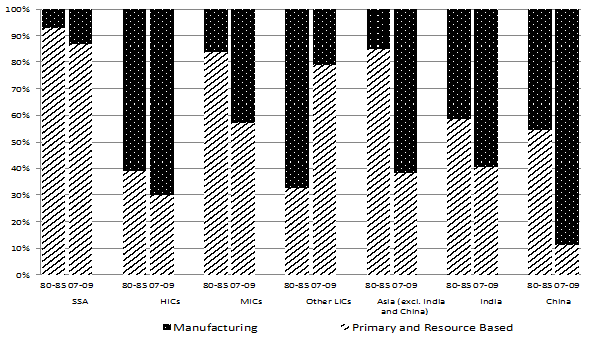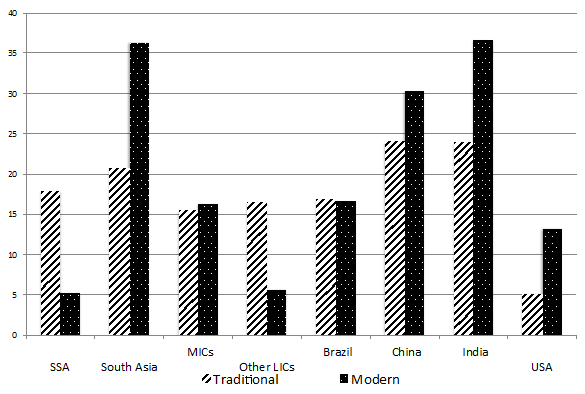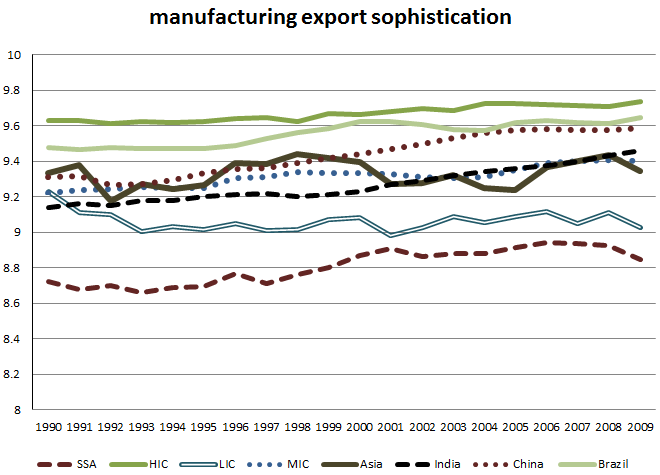Recent literature emphasises that a key component of the economic growth process is an increase in the “sophistication” of a country’s production. What a country produces and exports matters for growth; indeed, it has been argued that “… not all goods are alike in terms of their consequences for economic performance. Specialising in some products will bring higher growth than specialising in others” (Hausmann et al. 2007; Lall et al. 2005).
This column makes four key contributions to the debate. First, it systematically documents changes in export sophistication over the past 20 years in low-income countries and middle-income countries. In particular, it describes differences in the performance of different geographical regions, as well as between resource–rich and other economies.
Second, it analyses to what extent an increasing sophistication of production and exports is associated with overall economic growth. A related question concerns what factors and mechanisms ultimately determine the magnitude of this impact. That is, what determines whether sophisticated sectors act as an engine of growth for the broader economy, or instead turn into isolated enclaves?
Third, we examine what enables a country to increase the sophistication of its production. In this context, we look at the relative importance of institutional factors, structural reforms, and policy measures (such as exchange rate policy).
Fourth, and perhaps most novel, the analysis moves beyond the usual focus on goods, and also considers services. Services are gradually becoming more productive and tradable, as reflected in success stories such as India’s software and business-process activities, Nigerian’s film industry, or Kenya’s call centres (Mishra et al. 2011). Reflecting this, the paper analyses the transformation of global production using a new measure of the sophistication of services, in addition to the sophistication of goods.
Stylised facts
As a first step, Figure 1 documents how the composition of goods exports, in terms of primary products versus manufactures, has changed between the periods 1980–85 and 2007–09 in different regions. That is, to what extent have countries industrialised? Regions vary considerably, in terms of both the composition of their export basket, and changes over time in the relative importance of manufactures. In particular, the export baskets of low-income countries and sub-Saharan Africa are still dominated by primary and resource-based products, with little change over time.
Figure 1. Share of resources and of manufactures in total exports of goods
Source: Authors’ calculations using COMTRADE data.
Next, we divide manufactured exports into low-tech, medium-tech, and high-tech to get an indication of moves within the manufacturing value chain (Figure 2; see Lall 2000 for details on technology classification). The share of both medium and high-tech products in total manufactures has increased across the board, with a particularly large increase in China. However, the increase in sub-Saharan Africa and low-income countries has occurred from a smaller starting base.
Figure 2. Share of low-, medium-, and high-tech manufactured exports in total manufactured exports
Rapid technological innovations are globalising the market for services such as business processes, and the trend is likely to persist. Focusing on the past decade alone, modern services have been growing relatively fast in middle-income countries and in the BRICs (Figure 3). The opposite, however, holds for low-income countries and, in particular, for sub-Saharan Africa.
Figure 3. Traditional and modern service exports: Recent growth trends, 2000–07
Source: Balance of Payments Statistics, IMF. 2012.
Overall, the measured sophistication of exports of goods, manufactures, and services has risen over time (Figure 4). Levels of export sophistication are in general relatively low in low-income countries, and in particular in sub-Saharan Africa. Over time, sophistication has increased much faster in high-growth, rich economies than in slow-growing, poor economies. During the late 1990s and the 2000s, two developments characterised Asia and other emerging economies. First, the sophistication of goods increased rapidly, as resource-based production was replaced by more medium- and high-tech manufacturing. Second, service sophistication also rose, and the pace was particularly fast after 2000. India is a particularly interesting case. Service sophistication grew extremely fast, as service exports shifted away from traditional activities towards modern activities such as business and computer services.
Figure 4. Export sophistication for goods, manufactures, and services, 1990–2009
Source: Authors’ calculations.
Production sophistication: Impacts and determinants
Econometric analysis suggests that sophistication of exports is associated with faster growth. Perhaps even more importantly, we find that sophisticated sectors are more likely to act as an engine of growth for the broader economy, rather than turn into isolated enclaves, if the economy is liberalised, the exchange rate is not overvalued, and there are good information flows.
But what determines export sophistication itself? Overall, the results indicate that an educated workforce, external liberalisation, and good information flows are all significantly associated with greater sophistication of exports of goods and services. An appropriate macroeconomic policy, and in particular avoiding an overvalued exchange rate, plays a particularly important role in sustaining sophisticated goods exports. In addition, highly-skilled labour and good information flows are especially critical for sophisticated service exports.
What have we learnt?
Ultimately, the analysis yields three broad sets of conclusions.
- Rich and fast-growing countries have moved away from resource-based to manufactured exports.
In addition, many countries have witnessed an increase in the relative importance of modern services. Linked to this, they are benefiting from the on-going globalisation of services. However, low-income countries and sub-Saharan Africa have largely failed to share in these trends.
- Increasing sophistication of exports, of both goods and services, can be an important contributor to overall economic growth.
Sophisticated sectors are particularly likely to act as an engine of broader growth if the rest of the economy is not subject to significant distortions.
- Governments can play an important role in developing and sustaining exports of sophisticated goods and services, for instance through an appropriate macroeconomic policy and a focus on developing human capital.
Authors’ note: The views expressed here are those of the authors and should not be attributed to the IMF, the World Bank, or its Executive Board, or its management.
References
Hausmann, Ricardo, Jason Hwang, and Dani Rodrik, 2007, “What You Export Matters,” Journal of Economic Growth 12(1): 1–25.
Lall, Sanjaya, 2000, “The Technological Structure and Performance of Developing Country Manufactured Exports, 1985–98,” Oxford Development Studies 28(3).
Lall, Sanjaya, John Weiss, and Jinkang Zhang, 2005, “The ‘Sophistication’ of Exports: A New Measure of Product Characteristics,” Queen Elizabeth House Working Paper 123, Oxford University.
Mishra, Saurabh, Susanna Lundstrom, and Rahul Anand, 2011, “Service Export Sophistication and Economic Growth,” World Bank Working Paper 5606.











